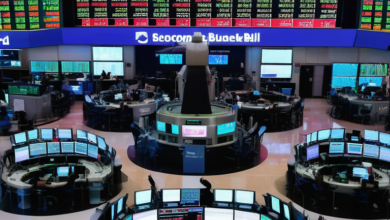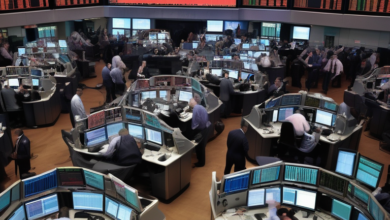Stock Market Roundup: July 26, 2024 Edition

Key Highlights
After a week full of ups and downs, US stocks ended on a high note. The Dow Jones Industrial Average saw an increase of 1.6%, and the S&P 500 went up by 1.1%. This rise came as investors looked closely at new inflation data from the US and reports about GDP that were better than what many expected.
- Leading the way was the Dow, which jumped up by 654.27 points.
- Both the S&P 500 and Nasdaq Composite also experienced increases.
- Big tech companies had mixed results in their earnings, leading to different outcomes for their stocks; however, healthcare shares got a boost thanks to some drugs getting approved.
- With oil prices changing often because of world events, energy companies felt those effects too.
- Meanwhile, businesses making consumer goods did well after seeing strong numbers in retail sales.
Stock Market Highlights: July 26, 2024 Edition
At the end of a tumultuous week, US stocks finished higher as people looked closely at the latest inflation numbers. The Dow Jones Industrial Average went up by 654.27 points or 1.64%, ending at 40,589.34. With an increase of 1.11%, the S&P 500 wrapped up at 5,459.10, while the Nasdaq Composite rose by 1.03% to finish off at 17,357.88.
The market’s bounce back was fueled by several factors: it seemed like stocks were too cheap not to buy (oversold sentiment), there was unexpectedly good news about how fast the economy is growing (GDP report), and investors felt hopeful that due to economic toughness (resilience), the Federal Reserve might start lowering interest rates soon.
1. Major indices see a notable upswing, with the Dow leading the charge
The big stock market numbers really went up, with the Dow Jones Industrial Average at the front. It jumped 654.27 points, or 1.64%, ending up at 40,589.34. This jump was because people were selling too much before, a report showed the economy doing better than we thought it would, and folks are thinking that the Federal Reserve might lower interest rates since our economy is showing some toughness. People investing money felt good about what’s coming next and started putting more of their money into parts of the market that go up and down a lot and also in smaller companies’ stocks. The Russell 2000 tracks these smaller company stocks and it went up by 1.67%. This shows that investors are starting to pay more attention to these areas.
2. Tech giants report mixed earnings, causing varied stock performances
In the world of tech, companies recently shared their earnings, and it was a bit of a mixed bag. This caused different reactions in their stock prices. For instance, despite some rough times during the week’s sell-off, Microsoft and Amazon both managed to increase by over 1%. Meta Platforms did even better with almost a 3% rise. With all this happening, the S&P’s information technology sector saw about a 1% jump too. Because these tech giants had such varied results from their earnings reports, investors found themselves scratching their heads trying to figure out what moves to make next regarding these stocks.
3. Healthcare stocks rally, driven by breakthrough drug approvals
Healthcare stocks went up because of some new drug approvals. With these drugs getting the green light, investors got really excited and started investing more in this sector. This jump was all about how much money these new drugs could make. The fact that healthcare stocks were doing so well shows that people believe this sector will keep making good money down the line.
Keywords: Healthcare stocks, breakthrough drug approvals, surge, investors, revenue
4. Energy sector reacts to fluctuating oil prices amidst geopolitical tensions
In the world of energy, things got a bit shaky because oil prices kept changing and there were some big disagreements between countries. Because of these ups and downs with oil prices, people who had money in energy companies found it tough to figure out what might happen next. They were trying to understand how all this could affect the cost of oil and how much money these companies could make. Even though times were uncertain, those investing in the energy sector stayed strong, keeping an eye on both the price of oil and any major global issues that popped up.
5. Consumer goods companies benefit from strong retail sales data
Companies that sell stuff we use every day saw their stocks go up because people were buying more things. With the numbers showing folks spent a lot of money shopping, these companies made more money too. This good news about how much everyone’s spending means those companies might keep doing well since it shows people have enough to spend on what they need or want.
Detailed Analysis of Market Movements
During this time, the market’s ups and downs were heavily influenced by two main things: what the Federal Reserve decided about interest rates and the information on inflation.
6. Wall Street’s response to Federal Reserve’s latest interest rate decision
Wall Street paid close attention to the Federal Reserve’s most recent decision on interest rates. By looking into this decision, investors were trying to understand what the central bank planned to do about money matters in the future. How much effect this choice had was clear from how it changed what people felt about investing and caused shifts in stock prices. From how folks reacted, you could tell they were making guesses on what might happen next with the economy and where interest rates would go from here.
7. Sector spotlight: Technology stocks’ volatile journey
During this time, tech stocks went on a rollercoaster ride because of different earnings reports that affected how they did. With an eye on the Nasdaq Composite, which leans a lot towards tech companies, investors watched these stocks closely. This up and down movement showed what investors were feeling and how their opinions about what’s next for the tech world kept changing.
8. Key earnings reports: Winners and losers of the day
Earnings reports were really important in deciding who did well and who didn’t on the stock market today. If a company’s earnings were better than what people thought they would be, that company was seen as a winner. On the other hand, if a company didn’t do as good as everyone hoped, it was seen as a loser. Investors paid close attention to these reports to figure out how financially healthy companies are and what their future might look like. Based on how each company performed in terms of earnings, investors made changes to their stocks which directly affected the stock prices.
9. Market trends: The rise of sustainable investing
During this time, a significant trend in the market was how sustainable investing became more popular. With an eye on companies that focus on environmental, social, and governance (ESG) factors, investors are now leaning towards investment options that are both responsible and sustainable. This change shows that if companies stick to ESG principles, they stand a better chance of drawing in investors and making the most out of this increasing trend.







